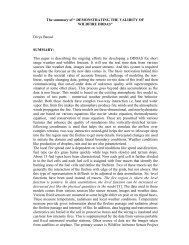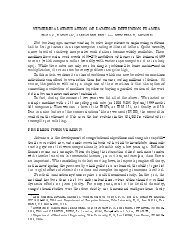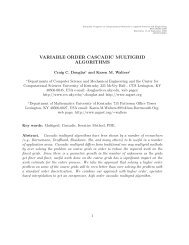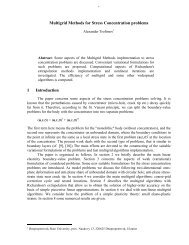Discrete Mathematics University of Kentucky CS 275 Spring ... - MGNet
Discrete Mathematics University of Kentucky CS 275 Spring ... - MGNet
Discrete Mathematics University of Kentucky CS 275 Spring ... - MGNet
You also want an ePaper? Increase the reach of your titles
YUMPU automatically turns print PDFs into web optimized ePapers that Google loves.
Examples: Let A = {1, 2, 3, 4}.<br />
• R 1 = {(1,1), (1,2), (2,1), (2,2), (3,4), (4,1), (4,4)} is<br />
o just a relation<br />
• R 2 = {(1,1), (1,2), (2,1)} is<br />
o symmetric<br />
• R 3 = {(1,1), (1,2), (1,4), (2,1), (2,2), (3,3), (4,1), (4,4)} is<br />
o reflexive and symmetric<br />
• R 4 = {(2,1), (3,1), (3,2), (4,1), (4,2), (4,3)} is<br />
o antisymmetric and transitive<br />
• R 5 = {(1,1), (1,2), (1,3), (1,4), (2,1), (2,2), (2,3), (2,4), (3,3), (3,4), (4,1),<br />
(4,4)} is<br />
o reflexive, antisymmetric, and transitive<br />
• R 6 = {(3,4)} is<br />
o antisymmetric<br />
Note: We will come back to these examples when we get around to<br />
representations <strong>of</strong> relations that work in a computer.<br />
159<br />
Note: We can combine two or more relations to get another relation. We use<br />
standard set operations (e.g., 3, 2, #, 4, …).<br />
Definition: Let R be a relation on a set A to B and S a relation on B to a set C.<br />
Then the composite <strong>of</strong> R and S is the relation S!R such that if (a,b),R and<br />
(b,c),S, then (a,c), S!R, where a,A, b,B, and c,C.<br />
Definition: Let R be a relation on a set A. Then R n is defined recursively: R 1 = R<br />
and R n =R n!1 !R , n>1.<br />
Theorem: The relation R is transitive if and only if R0R n , n












